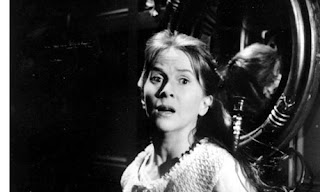“You mustn’t expect every night to be Halloween,” says a doctor in Robert Wise’s 1963 film, The Haunting. The doctor, a paranormal investigator, cautions his assistants not to expect too much from an allegedly haunted house. But left implied here is the fact that it is perfectly sensible to expect one night of the year to be Halloween, and, depending on the house you’re in, perhaps a few more.
This Halloween I’m reading about houses, first in the inspiration for The Haunting, the 1959 novel by Shirley Jackson, The Haunting of Hill House, and then in Virginia Savage McAlester’s Field Guide to American Houses.
Jackson was born in San Francisco in 1916, and wrote The Haunting of Hill House with the image in her mind of a specific, eerie-looking California mansion, although very little geography is actually given in the novel. The story begins with a paranormal investigator enlisting the help of three others to stay in Hill House and note its abnormalities. He describes the house as “disturbed.” “Leprous,” he says. “Sick. Any of the popular euphemisms for insanity; a deranged house is a pretty conceit.”
Much of the beginning of the novel is spent trying to pin down Hill House’s personality. The book drives home just how human-like houses really are. They are built by and for humans. Our most intimate moments are experienced inside them. And after all, they have faces. “No human eye can isolate the unhappy coincidence of line and place which suggests evil in the face of a house,” wrote Jackson, “and yet somehow a maniac juxtaposition, a badly turned angle, some chance meeting of roof and sky, turned Hill House into a place of despair, more frightening because the face of Hill House seemed awake, with a watchfulness from the blank windows and a touch of glee in the eyebrow of a cornice.”
Despite the despair of Hill House, the early scenes of its inhabitants exploring their new surroundings are comic and fun to read. Over time, however, one of the guests starts to steal the focus of the story, of the other guests, and of the house itself. After the recent death of her mother, 32 year old Eleanor Vance is freed from 11 years of her mother’s abusive demands. Ready to begin her life, she goes to Hill House. There, the forceful personality of the house meets the haunted past and expectant life of Eleanor, and, mysteriously, the two begin to meld. Or perhaps not so mysteriously. Isn't it natural for two personalities to influence one another? The house haunts Eleanor. Eleanor haunts the house.
With these thoughts from The Haunting of Hill House, I picked up A Field Guide to American Houses, looking not so much for roofs and facades but for haunted personalities. Organized chronologically and by style, the book is designed for the new homebuyer or the architecturally curious to look up a side-gable or a multi-level eave and identify a house the’ve seen in the wild. But after Hill House, the field guide became an encyclopedia of medical maladies, a casebook of the criminally insane.
The first thing I did was to try and identify Hill House itself—with its library in a stone tower, I thought perhaps a Gothic Revival house or a Richardsonian Romanesque.
Then I looked for other personalities. Jackson wrote in Hill House that “almost any house, caught unexpectedly or at an odd angle, can turn a deeply humorous look on a watching person; even a mischievous little chimney or a dormer like a dimple, can catch up a beholder with a sense of fellowship.” I wondered: are any of the houses in the guide humorous? I looked up mischievous little chimneys and dormers like dimples.
But Jackson went on, “a house arrogant and hating, never off guard, can only be evil.” Were there any arrogant houses in the guide? This one?
Or this one?
I looked again. Do they really appear deranged? Or, like Eleanor in Hill House, is my personality at play here? Am I deranged?
(Happy Halloween!)
For more:









No comments:
Post a Comment